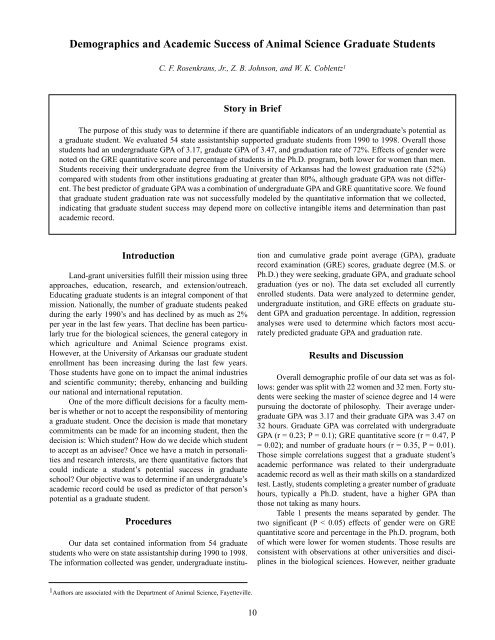Arkansas - Agricultural Communication Services - University of ...
Arkansas - Agricultural Communication Services - University of ...
Arkansas - Agricultural Communication Services - University of ...
Create successful ePaper yourself
Turn your PDF publications into a flip-book with our unique Google optimized e-Paper software.
Demographics and Academic Success <strong>of</strong> Animal Science Graduate Students<br />
C. F. Rosenkrans, Jr., Z. B. Johnson, and W. K. Coblentz 1<br />
Story in Brief<br />
The purpose <strong>of</strong> this study was to determine if there are quantifiable indicators <strong>of</strong> an undergraduate’s potential as<br />
a graduate student. We evaluated 54 state assistantship supported graduate students from 1990 to 1998. Overall those<br />
students had an undergraduate GPA <strong>of</strong> 3.17, graduate GPA <strong>of</strong> 3.47, and graduation rate <strong>of</strong> 72%. Effects <strong>of</strong> gender were<br />
noted on the GRE quantitative score and percentage <strong>of</strong> students in the Ph.D. program, both lower for women than men.<br />
Students receiving their undergraduate degree from the <strong>University</strong> <strong>of</strong> <strong>Arkansas</strong> had the lowest graduation rate (52%)<br />
compared with students from other institutions graduating at greater than 80%, although graduate GPA was not different.<br />
The best predictor <strong>of</strong> graduate GPA was a combination <strong>of</strong> undergraduate GPA and GRE quantitative score. We found<br />
that graduate student graduation rate was not successfully modeled by the quantitative information that we collected,<br />
indicating that graduate student success may depend more on collective intangible items and determination than past<br />
academic record.<br />
Introduction<br />
Land-grant universities fulfill their mission using three<br />
approaches, education, research, and extension/outreach.<br />
Educating graduate students is an integral component <strong>of</strong> that<br />
mission. Nationally, the number <strong>of</strong> graduate students peaked<br />
during the early 1990’s and has declined by as much as 2%<br />
per year in the last few years. That decline has been particularly<br />
true for the biological sciences, the general category in<br />
which agriculture and Animal Science programs exist.<br />
However, at the <strong>University</strong> <strong>of</strong> <strong>Arkansas</strong> our graduate student<br />
enrollment has been increasing during the last few years.<br />
Those students have gone on to impact the animal industries<br />
and scientific community; thereby, enhancing and building<br />
our national and international reputation.<br />
One <strong>of</strong> the more difficult decisions for a faculty member<br />
is whether or not to accept the responsibility <strong>of</strong> mentoring<br />
a graduate student. Once the decision is made that monetary<br />
commitments can be made for an incoming student, then the<br />
decision is: Which student How do we decide which student<br />
to accept as an advisee Once we have a match in personalities<br />
and research interests, are there quantitative factors that<br />
could indicate a student’s potential success in graduate<br />
school Our objective was to determine if an undergraduate’s<br />
academic record could be used as predictor <strong>of</strong> that person’s<br />
potential as a graduate student.<br />
Procedures<br />
Our data set contained information from 54 graduate<br />
students who were on state assistantship during 1990 to 1998.<br />
The information collected was gender, undergraduate institution<br />
and cumulative grade point average (GPA), graduate<br />
record examination (GRE) scores, graduate degree (M.S. or<br />
Ph.D.) they were seeking, graduate GPA, and graduate school<br />
graduation (yes or no). The data set excluded all currently<br />
enrolled students. Data were analyzed to determine gender,<br />
undergraduate institution, and GRE effects on graduate student<br />
GPA and graduation percentage. In addition, regression<br />
analyses were used to determine which factors most accurately<br />
predicted graduate GPA and graduation rate.<br />
Results and Discussion<br />
Overall demographic pr<strong>of</strong>ile <strong>of</strong> our data set was as follows:<br />
gender was split with 22 women and 32 men. Forty students<br />
were seeking the master <strong>of</strong> science degree and 14 were<br />
pursuing the doctorate <strong>of</strong> philosophy. Their average undergraduate<br />
GPA was 3.17 and their graduate GPA was 3.47 on<br />
32 hours. Graduate GPA was correlated with undergraduate<br />
GPA (r = 0.23; P = 0.1); GRE quantitative score (r = 0.47, P<br />
= 0.02); and number <strong>of</strong> graduate hours (r = 0.35, P = 0.01).<br />
Those simple correlations suggest that a graduate student’s<br />
academic performance was related to their undergraduate<br />
academic record as well as their math skills on a standardized<br />
test. Lastly, students completing a greater number <strong>of</strong> graduate<br />
hours, typically a Ph.D. student, have a higher GPA than<br />
those not taking as many hours.<br />
Table 1 presents the means separated by gender. The<br />
two significant (P < 0.05) effects <strong>of</strong> gender were on GRE<br />
quantitative score and percentage in the Ph.D. program, both<br />
<strong>of</strong> which were lower for women students. Those results are<br />
consistent with observations at other universities and disciplines<br />
in the biological sciences. However, neither graduate<br />
1 Authors are associated with the Department <strong>of</strong> Animal Science, Fayetteville.<br />
10

















